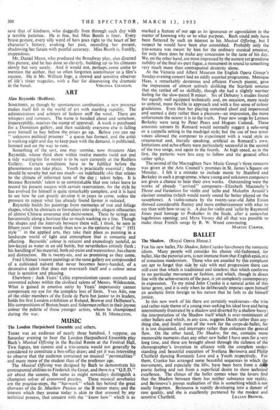MUSIC The London Harpsichord Ensemble and others.
DIERE was an audience of nearly three hundred, I suppose, on Saturday evening to hear the London Harpsichord Ensemble play Bach's Musical Offering in the Recital Room at the Festival Hall. Two fugues, ten canons and a trio-sonata would not generally be considered to constitute a box-office draw; and yet it was interesting to observe that the audience contained no musical "personalities" and many more of the student than of the professor age.
The Musical Offering was designed by Bach to demonstrate his contrapuntal abilities to Frederick the Great, and there is a "Q.E.D." air about the canons, the same as might nowadays distinguish a champion solver of crossword puzzles. These musical acrobatics are the practice-steps, the "bar-work" which lies behind the great choruses of the St. Matthew Passion or the B minor mass; and the interest which they arouse today is akin to that aroused by any technical process, that concern with the "know how" which is as marked a feature of our age as its ignorance or agnosticism in the matter of knowing why or to what purpose. Bach could only have been flattered by such an interest in his Musical Offering, but I suspect he would have been also astonished. Probably only the trio-sonata was meant by him for the ordinary musical amateur, for only there does he make any concession to the taste of his day. We, on the other hand, are most impressed by the austere yet grandiose nobility of the final six-part fugue, a monument in sound to something very much 'more than contrapuntal dexterity alone. At the Victoria and Albert Museum the English Opera Group's Sunday-evening concert had an oddly assorted programme. Monique Haas, a remarkably dexterous and efficient French pianist, gave the impression of almost actively disliking the Scarlatti sonatas that she rattled off so skilfully, though she had a slightly warmer feeling for the slow-paced B minor. Six of Debussy's studies found her equally well equipped technically and, on occasion, more ready to unbend, more flexible in approach and with a fine sense of colour gradations. Even then her playing remained aloof and impersonal and seemed a duty rather than a pleasure—an impression, the more unfortunate the nearer it is to the truth. Four new songs by Lennox Berkeley were sung by Peter Pears and Hugues Cuenod. These amorous sonnets by Ronsard would normally suggest a solo-song or a cappella setting in the madrigal style; but the use of two tenor voices allowed the composer to experiment with a vocal style as ornamental and, literally speaking, artificial as Ronsard's own. Imitations and echo-effects were particularly successful in the second of the two songs, and again in the fourth. At high speed, as in the first, the patterns were less easy to follow and the general effect rather spiky.
The second of the Macnaghten New Music Group's three concerts was given at the Arts Council's premises in St. James's Square on Monday. I felt it a mistake to include music by Stanford and Berkeley in such a programme, where young and unknown composers are given a chance to hear their own works. Outstanding were the works of already "arrived" composers—Elizabeth Maconchy's Theme and Variations for violin and 'cello and Malcolm Arnold's clarinet sonatina (which would surely sound far better played on the saxophone). A violin-sonata by the twenty-year-old John Exton showed considerable fluency and more embarrassment with what to say than with how to say it. A duo for violin and 'cello by Raymond Jones paid homage to Prokofiev in the finale, after a somewhat lugubrious opening; and Myra Verney did all that was possible to make three Fred& songs by R. W. Wood convincing.
MARTIN COOPER.


































 Previous page
Previous page